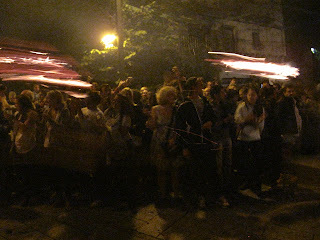I think I'll be letting you go
...Letting you go, Lupe Fiasco
cuando tú no estás
llueve por dentro, Luis Fonsi
I always postpone saying good-bye to Barcelona. It is difficult to let go of this amazing city with its vitality, dynamic energy, and awesome urban landscape.
Years ago when I first visited the Ciutat Comtal, several friends led me to the Ramblas to undergo a ritual of sorts. We first strolled down the Passeig de Gràcia, crossed the Plaça de Catalunya, and headed toward an ornate fountain on las Ramblas surrounded by tourists, locals, lots of people.
Years ago when I first visited the Ciutat Comtal, several friends led me to the Ramblas to undergo a ritual of sorts. We first strolled down the Passeig de Gràcia, crossed the Plaça de Catalunya, and headed toward an ornate fountain on las Ramblas surrounded by tourists, locals, lots of people.
The Font de Canaletes is the Barcelona's most popular meeting point, and a fixture of football fans and hooligans after Barça football matches since the 1930s.Originally dating to the 16th century, the current fountain was updated in the 19th century with a unique design that now sits prominently on the upper part of Las Ramblas, that magnificent, 1.2 km-long tree-lined pedestrian walk located between the Barri Gòtic and El Raval.
According to legend, a sip from the waters of this fountain will guarantee that one returns to Barcelona: "aquél o aquélla que beba de su agua volverá a Barcelona". My friends led me there to sip the waters to ensure that I would return. With much pomp, we neared the fountain, and I was urged to take a sip. I moved to the fountain and took a healthy handful of cool water and sipped. The experience was full of slapstick and fun. But I did sip the waters, and in my case, it has worked. I have returned countless times to this spot to look and relive moments of past visits and look forward to subsequent returns.
And now when I return to Barcelona, I return to reconnect and revive old friendships, discover new places, share time with the sights and sounds of this dynamic city. I´ve done the tourist thing years ago. But frankly, Barcelona is much more than tourism and museums.
So if you are still busy being a tourist, let go and say "Hola" to this city and embrace its energies. Sip the waters of Canaletes. Change and experience the diversities of Barcelona.
Yes, I must now say "adéu". And begin planning my next visit to this city. And I leave with this lovely video found on YouTube. Hope you like it.
So if you are still busy being a tourist, let go and say "Hola" to this city and embrace its energies. Sip the waters of Canaletes. Change and experience the diversities of Barcelona.
Yes, I must now say "adéu". And begin planning my next visit to this city. And I leave with this lovely video found on YouTube. Hope you like it.
¡Disfrutad!














































